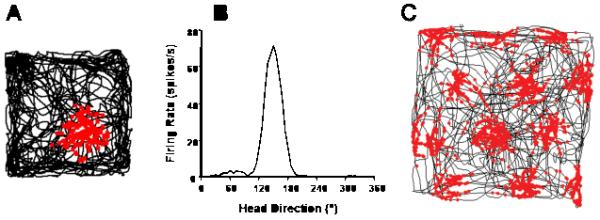Figure 1.

(A) The firing pattern of a typical hippocampal place cell, recorded as a rat foraged in an environment 70 cm square with 50 cm high walls. The path of the rat is shown by the stippling and the action potentials of the cell are shown as small squares, each plotted at the location of the rat at the time it occurred. Note that this particular cell prefers to fire slightly south-east of the centre of the box, and was silent elsewhere. (B) The firing pattern of a typical head direction cell (adapted from (Golob & Taube, 1999)). This cell fired everywhere in the environment (not shown), but only when the rat’s head was pointing in a particular, highly restricted direction. (C) The firing pattern of a typical entorhinal grid cell (adapted from Hafting et al., 2005), shown in the same format as the place cell in (A). Note that like the place cell, this grid cell fired in a spatially localized way, but unlike the place cell it had multiple, regularly-spaced firing locations.
